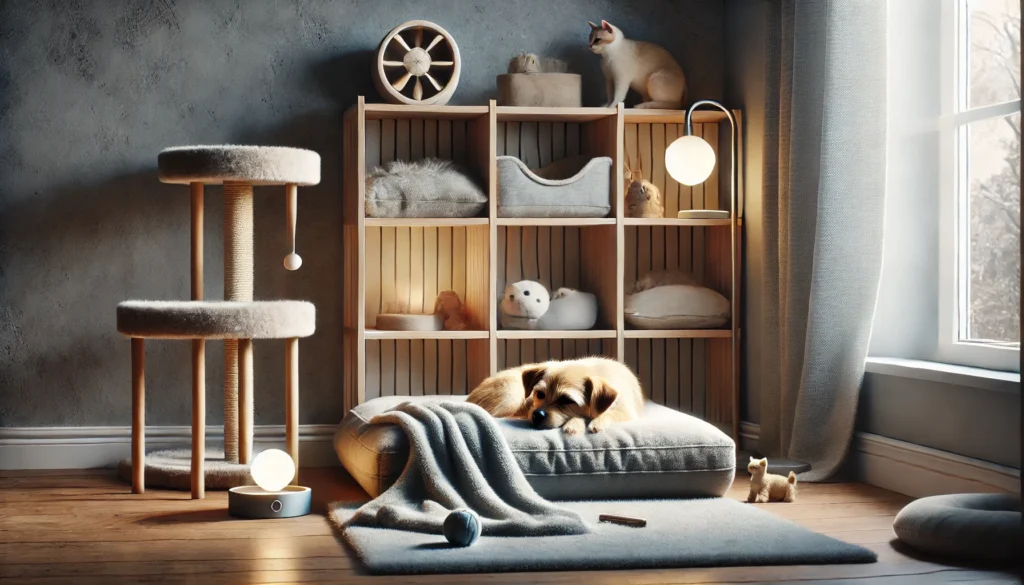Stress in pets often goes unnoticed until it shows up as excessive barking, hiding, destructive behavior, or even changes in appetite. Whether you live in a bustling home, a compact apartment, or a multi-pet household, creating a designated “relaxation corner” can significantly improve your pet’s sense of safety and emotional balance.
This article will walk you through how to set up a calming retreat space for your dog or cat, with simple, thoughtful elements that offer comfort, predictability, and peace.
Why Pets Need a Dedicated Calm Space
Pets don’t always have control over their environment. Loud noises, visitors, kids, and even vacuuming can leave them overwhelmed.
A dedicated relaxation corner provides:
- A personal retreat to reduce overstimulation
- A safe place during storms, fireworks, or visitors
- Support for anxiety, especially in rescues or sensitive animals
- A tool to manage reactivity or behavior training
- A consistent “go-to” space for decompressing
Dogs and cats both benefit from having a calm zone — even if they never seem anxious.
Key Features of a Good Relaxation Corner
Your pet’s calm zone should check a few important boxes:
- Quiet: Away from doorways, loud appliances, or high traffic
- Accessible: Easy for your pet to reach on their own
- Comfortable: Soft bedding, familiar smells, gentle lighting
- Enriching: Toys, chews, or calming scents (optional)
- Safe: No wires, sharp objects, or escape risk
Even a small nook or crate can become a powerful source of peace.
Choosing the Right Location
The ideal space depends on your layout and your pet’s personality.
For dogs:
- A corner of the living room or bedroom
- Under a desk or table
- Inside a covered crate
- Behind a pet gate or curtain
For cats:
- A quiet shelf or closet corner
- Under the bed with a blanket and soft light
- A cardboard box lined with fleece
- A window perch with shaded curtains
Watch where your pet naturally retreats to — and build their space there.
What to Include in the Relaxation Space
Here’s how to create a multisensory calming environment:
1. Comfortable bedding:
- Orthopedic mat or memory foam for dogs
- Soft fleece or thermal-lined pad for cats
- Blankets or clothing that smell like you
2. Familiar items:
- Favorite toy or chew
- Pet-safe comfort object (e.g., a small plush)
- Treat-stuffed toy or calming lick mat
3. Calming aids:
- Pet pheromone diffuser (Adaptil for dogs, Feliway for cats)
- Sound machine with white noise or soft music
- Gentle lavender spray (pet-safe and diluted)
4. Boundaries (optional):
- Crate with cover
- Portable playpen or baby gate
- Tension rods with curtain for visual privacy
Don’t overfill the area — it should feel open and peaceful, not cluttered.
Introducing Your Pet to the Space
Start by making the area appealing, not restrictive.
- Allow them to explore at their own pace
- Sit nearby while reading or relaxing so they feel your presence
- Offer treats or toys inside the area to create positive associations
- Avoid using the space for punishment — it should only represent calm and safety
Cats may take longer to claim a new space. Let them approach it naturally.
When to Use the Relaxation Corner
A calm zone is helpful in a variety of daily or occasional situations:
- During storms, fireworks, or home renovations
- When guests visit
- After walks, grooming, or vet visits
- When the home is busy (kids, cleaning, delivery noises)
- Before or after crate training or training sessions
- To teach “place” or “settle” cues
Over time, your pet will choose to go there voluntarily when they feel stressed.
Tips for Multi-Pet Homes
Each pet should have access to their own safe spot:
- Use separate corners, beds, or crates
- Avoid competition over shared spaces
- Teach pets to respect each other’s retreat zones
- Rotate enrichment toys between them to keep things fresh
A peaceful home starts with everyone having a space of their own.
Portable Calm Zones
Need flexibility? Create a mobile version:
For dogs:
- Foldable crate with a pad and chew
- Calming spray and collapsible water bowl
- Familiar blanket or crate cover
For cats:
- Pop-up tent or enclosed bed
- Carboard box with soft towel
- Small towel with catnip or silvervine
Great for hotel stays, visits to family, or during home renovations.
Signs It’s Working
You’ll know the space is helping when your pet:
- Seeks it out voluntarily
- Shows fewer signs of stress or reactivity
- Settles more quickly after stimulation
- Uses it during household activity without prompting
Celebrate these milestones — they’re signs of emotional regulation and trust.
A Sanctuary for Every Pet
A relaxation corner might seem like a small change, but for a stressed or overstimulated pet, it can make all the difference. Whether it’s a window shelf for your cat or a cozy crate with calming sounds for your dog, this space gives your pet the choice to retreat, regroup, and rest.
In a world full of noise and unpredictability, that quiet corner becomes a sanctuary — one they’ll come to love as much as you do.






